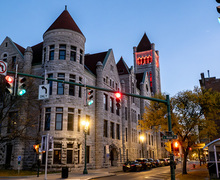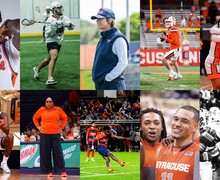Pay of top SU athletic, executive officials on par with peer institutions
The way William Zumeta sees it, the high salaries of top college officials around the country are just the cost of business.
‘In general, you have got to meet the market,’ said Zumeta, senior fellow of The National Center for Public Policy and Higher Education.
On Nov. 14, The Chronicle of Higher Education released an analysis looking at 448 private college presidents nationwide and listed Syracuse University Chancellor Nancy Cantor as the 14th-highest paid with a total compensation of nearly $1.4 million.
Despite earning six and sometimes seven figures, the salaries of top SU executive and athletic officials are within range of their counterparts at peer institutions. SU spokesman Kevin Quinn said New York University, Boston University, Boston College and the University of Southern California are among SU’s peers. Although SU is within range of all four private universities in terms of academics, Quinn said BC and USC have Division I athletic programs comparable to SU.
Yet during a time when universities are facing significant budget cuts and tuition increases, the increasing salaries of college officials can cause concerns, especially as athletic officials continue to take over the reins as the top earners at universities.
Athletic officials
Three of the top four earners at SU in 2008 were athletic officials, according to the university’s 2009 Internal Revenue Service Form 990 report, the most recent report available.
Quinn, who declined to disclose current SU football coach Doug Marrone’s salary, said the high salaries of athletic officials is a direct result of today’s aggressive marketplace.
‘To have a strong Division I program in football or basketball, you need to be competitive in terms of salaries when it comes to coaches’ salaries,’ he said. ‘If you want to be excellent, you have to be able to attract strong coaches across the board.’
Men’s basketball head coach Jim Boeheim had the highest base compensation at SU with $1,133,428. Ranking second was former head football coach Greg Robinson, who made $1,095,987. Athletic Director Daryl Gross had a base salary of $490,155, making him the fourth-highest paid SU employee, directly behind Cantor.
Although both Boeheim and Robinson had salaries on par with peer Division I athletic programs at USC and BC, Gross was the top earner among athletic directors at the three schools.
At Boston College, Athletic Director Eugene DeFilippo made a base salary of $327,797. USC Athletic Director Michael Garrett made nearly $21,000 less than Gross with a salary of $469,248.
BC’s football and basketball coaches also had a lower base compensation than their counterparts at SU. Former BC head football coach Jeff Jagodzinski earned $1,048,741, about $47,000 less than SU’s former football coach Robinson. Al Skinner, the former men’s basketball coach at BC, earned $964,184, nearly $170,000 less than Boeheim.
But at USC, the salaries of former football coach Pete Carroll and former men’s basketball coach Tim Floyd were significantly larger than those of SU’s coaches. In 2008, Carroll, now the head coach of the Seattle Seahawks, earned $3,466,772 in base salary. Floyd earned $1,426,237, almost $300,000 more than Boeheim.
The high salaries of college athletic coaches and officials are not out of the ordinary.
Zumeta, the senior fellow of The National Center for Public Policy and Higher Education, said although it is common to find football and basketball coaches in the top-earners list, the more interesting aspect is to find out where the money is coming from. At most universities, athletic coaches’ salaries are funded by the income brought in from athletics instead of the college’s revenue, he said.
Ron Ehrenberg, director of the Cornell Higher Education Research Institute, agrees and said undergraduate tuition and state appropriations are not paying a large fraction of the salaries.
‘Unfortunately, it is very common,’ Ehrenberg said in regards to the high salaries of coaches. ‘But what many presidents will tell you is that the salaries of these high-paid people are covered by the revenue that the athletic programs bring in.’
At SU, all athletic department salaries, which includes coaches and officials, such as the athletic director, are paid for out of athletics revenues, Quinn said. Income from athletics includes ticket sales, gifts, sponsorships and other income, he said.
Ehrenberg said SU’s strong reputation for basketball helps to justify the high salaries of its coaches.
‘Syracuse fills up the Dome for every basketball game,’ he said. ‘And the basketball players come to Syracuse to play for Jim Boeheim, so there’s a big connection there.’
Executive officials
Similar to SU coaches, the salaries of top executive officials were within range of their counterparts at the university’s peer institutions.
The midrange salaries of officials can be attributed to the Board of Trustees, Quinn said. The board has a committee that looks at the compensation for the chancellor and senior officer of the university every year, he said.
They commission a salary comparison report each year from an independent consulting firm, which looks at a group of about 30 of SU’s peers, he said. The firm sets the core group of institutions that makes up the comparison group and provides information to the Board of Trustees for what the range of salaries are for top positions at peer institutions.
‘In each of the major jobs, the Board of Trustees’ goal is to have salaries that are competitive but yet in the midrange of the level of our peers,’ Quinn said. ‘That’s essentially where the senior officer positions are in the midrange of that group.’
Cantor made less in 2008 than presidents at BU, NYU and USC. BC’s president, the Rev. William Leahy, is not on the top-earners list for the college.
Cantor’s base salary for the calendar year 2008 was $598,758, making her the third-highest paid SU official. Her salary was also nearly $93,000 less than BU President Robert Brown, who was the highest-paid official at BU.
President Steven Sample of USC was the fourth-highest paid officer at $827,597, ranking behind athletic coaches Pete Carroll, Tim Floyd and Steve Sarkisian, the former offensive coordinator of the USC football team. At NYU, President John Sexton earned about $640,000 more than Cantor. Despite the seven-figure salary, Sexton was only seventh on the top-earners list at NYU, behind five doctors and the dean of the School of Medicine.
College presidents’ high salaries are unsurprising to several experts.
‘The jobs certainly have become tougher and more complex, but another aspect of it is in the competition for top talent. People keep bidding against each other, and that sort of pushes the prices up,’ Ehrenberg said.
Ehrenberg said being a college president is a 24/7 job not many executive officials are willing to take on.
In a Nov. 14 statement, David Warren, president of the National Association of Independent Colleges and Universities, cited a study from the Council of Independent Colleges that said about one in four chief academic officers at private colleges plan to pursue a presidency.
With the lack of potential presidents, Zumeta said salaries have increased over the years because universities have to compete to get the best talent.
Eric Spina, SU’s vice chancellor and provost, was the sixth-highest paid official at SU during 2008 with a base salary of $414,946. Like Cantor, he was also the lowest compensated among SU’s peers.
But Louis Marcoccia, SU’s executive vice president and chief financial officer, was compensated more within range of SU’s peer institutions. Marcoccia was the fifth-highest paid university official in 2008 with a base compensation of $447,281.
At BC, Executive Vice President Patrick Keating made more than $50,000 less than Marcoccia made in 2008. Keating was the fifth-highest compensated employed at BC.
Martin Howard, the chief financial officer at BU, made $292,733. Howard ranked seventh on the university’s top-earners list. Both the executive vice presidents at NYU and USC earned more than $500,000.
But one SU official did make more than his counterpart at NYU. Kenneth Shaw, a current professor in the Martin J. Whitman School of Management and SU’s chancellor from 1991 to 2004, made $331,250 in 2008 and was the eighth-highest paid SU employee. NYU President Emeritus John Brademas made $321,376, and BU President Emeritus Aram Chobanian made $281,356, nearly $50,000 less than Shaw.
Shaw negotiated, as part of his contract, an agreement that allowed him to return to the faculty for a certain number of years at a salary below what he was receiving as chancellor, Quinn said. The last two chancellors at SU have gotten dual appointment as a chancellor and a faculty member, he said.
Unlike athletic officials’ salaries at SU, the money for executive officials’ salaries comes from the college’s general revenue, Quinn said. The university’s revenue for the 2008-09 fiscal year was $828,608,567, according to SU’s IRS Form 990. Quinn said the number includes tuition, gifts, sponsored research, investment gains and other income.
Concerns
Although most of SU officials’ salaries are within range of their counterparts at peer institutions, there is still some room for concern.
Zumeta said when college officials are paid more than $1 million, it causes a public appearance problem for the institution, as people think university officials should not be paid like corporate executives.
‘The appearance of higher-level salaries causes people concern,’ he said.
If salaries continue to increase down the road, problems may also arise, said Ehrenberg, director of the research institute at Cornell.
‘That’s problematic,’ he said, ‘and the reason that’s problematic is because, in truth, although the salaries of these top officials are a very small part of the university budget, symbolically, it’s a problem if leaders’ salaries keep going up in a time when the universities are facing severe budget problems.’
Published on December 6, 2010 at 12:00 pm
Contact Jon: jdharr04@syr.edu





